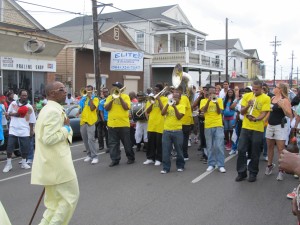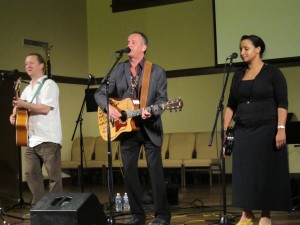It has been about a day and a half since we collectively arrived in New Orleans. Is spite of flooding in the south and related thunderstorms, neither Southwest 737s or minivans, ran into weather delays. A burning tractor trailer in East Tennessee led to frustrating delays for of the two groups; however we were all safely in New Orleans by late afternoon on Saturday, March 12th.

Kyle and Bill, Irish Channel St. Patrick’s Parade 2016
Two of the groups arrived in time to take part in the Irish Channel St. Patrick’s Parade Uptown. And, as they would find out firsthand over the next 24 hours, in New Orleans participation in parades is strongly encouraged. Whether it catching throws or passionately engaging with marchers for St. Paddy’s or dancing in a second line, you are generally part of the event.
At 5:30 in the afternoon, all four groups converged on the North Rampart Community Center, which is tucked in the the northeast corner of the French Quarter. Director “Coach” Parker welcomed us and provided the students with combination tour, orientation, and history lesson. The class was impressed with the facility; it would take a while for them to realize how good the location is.
In what has become a New Orleans trip, first-night tradition, the students headed over to the Joint, in the Bywater, an excellent barbecue place in a town not famous for its barbecue. With our arrival, the line quickly went out the door onto Mazant Street. It took a while by the end of the line the choice of smoked meats began to dwindle, but everyone was seated, fed, and left quite full, thank you. A few students braved exhaustion and took a brief walk into the Quarter, but most took advantage of hot showers and the potential for a full night’s sleep.

Jazz Mass at St. Augustine’s, March 2016.
The next morning, most students ventured two blocks into Treme to attend the Jazz mass at St. Augustine’s Roman Catholic. I warned them that it was long, but for me it is a “not-to-be-missed” part of any visit to New Orleans, and I guess it’s hard to hide that level of sentiment. The students immediately felt the community and faith of the congregation of this, the oldest African-American Catholic Church in the nation’s first black neighborhood.

Students with Mardi Gras Indian, March 2016
It was the perfect start to a day that appeared focused on both Treme and New Orleans parade culture. After mass, the class gathered at Congo Square in Louis Armstrong. This spot was where African slaves were permitted to drum, dance, and sell their wares on Sunday. And in the process, contributed to the preservation of African rhythms that became one of the catalysts for the development of jazz. And while waiting to link up with this Sunday’s second line parade, students were treated to the sights and sounds of Mardi Gras Indians who had marched down from Bayou St. John.

Second Line, Esplanade Avenue, March 2016.
The Keep ‘N It Real Second Line appeared to be more elusive, or at least, it took longer for it to make its way towards where we were waiting. We ended up walking over to Claiborne and St. Bernard. Students first appeared taken aback by the singing, dancing, twerking, horn playing crowd that enveloped us, but most second lined through the Seventh Ward and Treme, and a few followed it all the way back to Bayou St. John. It was a big hit.

Li’l Dizzy’s, March 2016
Appropriately, we reconnected at Li’l Dizzy’s, an Afro-Creole restaurant on the edge of Treme. Once again, we were treated to the best gumbo in the City, along with fried chicken, greens, macaroni and cheese, and bread pudding, all washed down with brewed ice tea. We tried valiantly, but the buffet won in the end. Some went back to the Center to rest after a full day of activities, while others followed the siren’s song of the French Quarter.

Harry “Swamp Thing” Cook, Hot 8 Brass Band, March 2016.
At 10pm, we met up at the Howlin’ Wolf in the warehouse district for a performance by the Hot 8 Brass Band. Most had stereotyped images of brass band music, likely picturing a cross between marching band and traditional jazz. They were totally unprepared for what hit them. In the end, most was stay through both sets to funked up music in a packed, brick room. For them a day of music, dancing, and traditional Creole cooking, would come to an exhausted, yet satisfying end. A day in which entertainment tested endurance and highlighted new and unexpected experiences.
And then there would be work.




























